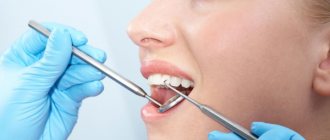| [organizational and legal form, name of organization, enterprise] | I approve [position, signature, full name of the manager or other official authorized to approve the job description] [day month Year] M.P. |
Job description of a dental hygienist [name of organization, enterprise, etc.]
This job description has been developed and approved in accordance with the provisions of the Labor Code of the Russian Federation and other regulations governing labor relations in the Russian Federation.
Dental hygienist: what he does and what he treats
The oral cavity is an exceptional ecosystem for the vital activity of microflora, which can cause diseases of the teeth and surrounding tissues. One of the main reasons influencing the composition of microflora is the hygienic condition of the oral cavity. Mineral deposits and soft plaque are an excellent breeding ground for bacteria. There are many medical specialties in dentistry, but only a specialist hygienist can clean your teeth perfectly and restore your smile’s attractiveness.
Personal qualities
Before enrolling as a full-time or part-time student at a university, you need to find out where to study and what personal qualities will be needed in your future profession. Their presence or absence will help determine the appropriateness of choosing an applicant.
Required qualities:
- accuracy;
- pedantry;
- politeness;
- responsibility;
- determination;
- communication skills;
- persistence;
- altruism.
What is a dental hygienist?
A dental hygienist is a specialist with a higher or secondary specialized education who has received the specialization “Preventive Dentistry” or “Dental Hygienist”. This is a doctor who professionally knows all aspects of proper oral care.
Responsibilities within the competence of a dental hygienist:
- preventive examination, assessment of the condition of the oral cavity;
- primary diagnosis of periodontal and dental diseases;
- drawing up an individual oral care program;
- providing assistance in selecting dental hygiene products;
- teaching patients how to care for orthodontic and orthopedic systems;
- choice of technology and removal of dental plaque;
- polishing minor defects (irregularities) of fillings;
- strengthening enamel with special pastes;
- explanation of the rules for brushing teeth;
- Providing consulting assistance in their specialization to dentists of other profiles.
Obstetrician-gynecologist Obstetrician-gynecologist. Job description.
1. General provisions 1.1. An obstetrician-gynecologist belongs to the category of medical specialists and is directly subordinate to _________________________________. (position of immediate supervisor) 1.2. A doctor who has completed specialization in obstetrics and gynecology or has experience in this specialty is accepted for the position of obstetrician-gynecologist. 1.3. An obstetrician-gynecologist is hired and quits ____ __________________. (position) 1.4. An obstetrician-gynecologist is obliged to apply in practice the principles of scientific organization of work, actively use electronic computing and medical-diagnostic equipment in relation to the profile of his activity, be able to navigate modern scientific and technical information, effectively use it to solve practical problems, and show initiative. - initiative, integrity and conscientiousness in work, promote a healthy lifestyle and follow its principles. 1.5. An obstetrician-gynecologist must know: - the basics of healthcare legislation and directive documents defining the activities of healthcare authorities and institutions; — organization of obstetric and gynecological care in the country, organization of ambulance and emergency care; — maternal and perinatal mortality rates and measures to reduce them; — basics of topographic anatomy of body regions and, first of all, the anterior abdominal wall and abdominal cavity, retroperitoneal space, pelvis and urogenital region in normal and pathological conditions; — the main issues of normal and pathological physiology, respectively, in healthy women and in obstetric and gynecological pathology; — the relationship between the functional systems of the body and the levels of their regulation; — physiology and pathology of a woman’s menstrual function; — physiology and pathology of pregnancy, childbirth and the postpartum period, risk groups; — causes of pathological processes in a woman’s body, mechanisms of their development and clinical manifestations; — the influence of production factors on the specific functions of the female body; — physiology and pathology of the hemostatic system, indications and contraindications for transfusion of blood and its components; — the basics of water-electrolyte metabolism and the acid-base state of the blood, possible types of their disorders and principles of treatment; — general and special research methods in obstetrics and gynecology, including the functional state of the ovaries; — basics of the use of endoscopy and x-ray radiology for the examination and treatment of gynecological patients; — issues of asepsis and antiseptics in obstetrics and gynecology; — basics of immunology and genetics in obstetrics and gynecology; — principles, techniques and methods of pain relief in obstetrics and gynecology, the basics of intensive care and resuscitation in women and newborns; — basics of infusion therapy in obstetrics and gynecology, characteristics of blood products and blood substitutes; — basics of pharmacotherapy in obstetrics and gynecology; — principles of preoperative preparation and postoperative management of patients, rehabilitation methods; — basics of the pathogenetic approach when conducting therapy in obstetrics and gynecology; — basics of physiotherapy and physical therapy in obstetrics and gynecology, indications and contraindications for sanatorium treatment; — basics of rational nutrition and principles of diet therapy in obstetric and gynecological practice; — new modern methods of prevention and treatment of obstetric and gynecological pathology, as well as unplanned pregnancy; — basics of oncological vigilance for the purpose of prevention and early diagnosis of malignant neoplasms in women; — issues of temporary and permanent disability, medical labor examination in obstetrics and gynecology; — organizing and conducting clinical examinations of women, analyzing its effectiveness; — features of the sanitary and epidemiological regime in the departments of the obstetric and gynecological hospital, in the antenatal clinic; — indications for hospitalization of pregnant women and gynecological patients; — equipment and facilities for operating rooms and intensive care wards, safety precautions when working with equipment, surgical instruments used in various obstetric and gynecological operations; — principles of working with monitors; — fundamentals of legal law in obstetrics and gynecology; — issues of organizing the civil defense medical service; — prevention, diagnosis, clinic and treatment, be able to diagnose and provide the necessary assistance in the following emergency conditions: traumatic shock, acute blood loss (including premature placental abruption), eclampsia, acute cardiovascular and respiratory failure. 1.6. An obstetrician-gynecologist must be able to: - obtain information about the course of pregnancy and the disease; — identify risk factors for the development of one or another obstetric and gynecological pathology and organize preventive measures; - apply objective methods of examining a pregnant woman, a patient, to identify general and specific signs of a gynecological disease or pregnancy complication; — assess the severity of the patient’s condition, determine the volume and sequence of resuscitation measures; — provide the necessary urgent assistance in case of emergency conditions; — determine the need to use special research methods (laboratory, radiological, endoscopic, functional), interpret the data obtained; — identify early signs of pregnancy, determine its timing, fetal position, pelvic size; — determine the indications for hospitalization of a pregnant or gynecological patient, organize hospitalization in accordance with the woman’s condition; — draw up a differentiated management plan for a pregnant woman and carry out its correction over time; — develop a plan for preparing the patient for emergency or planned surgery, determine the degree of disruption of homeostasis, and prepare all functional systems of the body for surgery; — determine the blood type and perform intravenous or intra-arterial blood transfusion, reinfusion; identify possible transfusion complications and carry out the necessary treatment and preventive measures; — apply, according to indications, an adequate method of pain relief in obstetric and gynecological practice; - resolve the issue of the patient’s ability to work; — maintain medical documentation, ensure continuity between treatment and preventive institutions; - prevent unplanned pregnancy; — carry out clinical examination and evaluate its effectiveness; — analyze the main performance indicators of a medical institution; — carry out sanitary educational work; — establish the duration of pregnancy, assess the health status of the pregnant woman, identify possible disorders and carry out a set of dispensary measures; — identify signs of early or late pregnancy pathology (early and late toxicosis, dropsy, nephropathy, eclampsia) and take all necessary measures to eliminate it; — perform external and internal obstetric examination, determine the phase of labor and the position of the fetus, the degree of maturity of the cervix; — carry out physiological childbirth, childbirth with an occipital or cephalic presentation of the fetus; — promptly recognize and carry out childbirth in cases of extensor presentation of the fetus, breech presentation, large fetus and multiple pregnancies; - assess the degree of narrowing of the pelvis, justify the most rational tactics and implement it; — timely determine the indications for cesarean section; — justify the tactics for the transverse position of the fetus and implement it; — justify the tactics of labor management for extragenital diseases; - determine labor anomalies (primary weakness, secondary weakness, rapid and rapid labor) and regulate labor; — establish the cause of obstetric hemorrhage (placenta previa, premature abruption, atonic bleeding) and provide the necessary assistance for this condition; — establish signs of intrauterine fetal hypoxia and provide the necessary assistance; — perform resuscitation measures for asphyxia and birth trauma of a newborn; — assess the course of the postpartum period, identify postpartum complications and combat them; — identify complications of the newborn period, develop therapeutic measures and carry them out; — establish a diagnosis and carry out the necessary treatment for the following diseases: ectopic pregnancy, out-of-hospital abortion, genital tuberculosis, inflammatory diseases of the female genital organs of septic etiology, abnormalities in the position of the genital organs, gonorrhea in women, trichomoniasis of the genitourinary organs, dishormonal diseases, benign venous tumors of the uterus and appendages, malignant tumors of the uterus and appendages. 2. Operations and manipulations 2.1. An obstetrician-gynecologist performs the following operations and manipulations: — colposcopy; — diagnostic curettage of the uterine cavity; — curettage of the uterine cavity during termination of pregnancy; - classic manual; — fetal extraction; - obstetric forceps; - massage of the uterus with its atony; - C-section; - suturing rupture of the cervix, vagina, perineum; — manual separation and release of placenta, manual control of the uterine cavity; — laparotomy for ectopic pregnancy and torsion of ovarian cyst; — puncture of the posterior fornix; — hydrotubation; - amniotomy; - hysterosalpingography; - amputation of the uterus; - targeted biopsy; — removal of a polyp of the cervical mucosa; — catheterization of the bladder; - gastric probing; - siphon enema; - venesection, intravenous infusions, blood transfusion. 3. Job responsibilities 3.1. The main task of an obstetrician-gynecologist is to provide qualified obstetric and gynecological care. 3.2. In accordance with the main task, the obstetrician-gynecologist ensures: 3.2.1 an appropriate level of observation, examination and treatment of women in accordance with the principles of the medical and protective regime and compliance with the rules of medical deontology; 3.2.2 timely provision of maternity leave in accordance with current legislation, sick leave in cases of temporary disability, referral to a medical advisory commission and VTEK; 3.2.3 carrying out sanitary education work among women; 3.2.4 systematically carrying out activities to improve the qualifications of middle and junior medical personnel. 4. Rights and obligations 4.1. An obstetrician-gynecologist is obliged to: 4.1.1 know and be able to apply in practice modern (tested) methods and means of examination, diagnosis and treatment; 4.1.2 conduct daily rounds in the wards together with the midwife (nurse); 4.1.3 participate in rounds of the head of the department and report to him about hospitalized women, and, if necessary, take part in consultations with patients; 4.1.4 participate in the reception of pregnant women, women in labor, postpartum women and patients entering the department during its opening hours; carry out their examination, prescribe the necessary therapeutic and diagnostic measures and fill out medical records in the prescribed manner; 4.1.5 be on duty in accordance with the approved schedule; 4.1.6 transmit to the hospital doctor on duty a list with the names of patients requiring special monitoring; 4.1.7 when contacting relatives in person, provide information about the health status of women in labor, postpartum women and patients, taking into account the principles of maintaining medical confidentiality; explain to relatives and the woman herself the inappropriateness and harm of premature discharge or further hospital stay; 4.1.8 report to the head of the department, and in his absence, directly to the deputy chief physician for the medical unit (or chief physician): - about life-threatening changes in the health status of patients and about all cases of death; — about gross violations of internal regulations by medical personnel and patients; 4.1.9 systematically improve your qualifications. 4.2. An obstetrician-gynecologist has the right to: 4.2.1 prescribe and cancel (previously prescribed by the doctor himself) any therapeutic and diagnostic measures arising from the changing condition of the patient and the availability of diagnostic and treatment capabilities; 4.2.2 check the correctness and timeliness of implementation by nursing and junior medical personnel of appointments and instructions for the treatment and care of women, keeping them in proper cleanliness and tidiness; 4.2.3 discharge and transfer the woman to another department of the maternity hospital or another medical and preventive institution in agreement with the head of the department; 4.2.4 instruct subordinate employees of the department to make proposals to reward these employees or impose disciplinary sanctions on them for individual omissions in work or violation of internal labor regulations; 4.2.5 issue sick leave certificates in accordance with current instructions. 5. Responsibility 5.1. An obstetrician-gynecologist is responsible for violations of the rights of citizens in the field of health care resulting from failure to fulfill or improper performance of his professional duties, in accordance with the legislation of the Russian Federation. 5.2. In the event of a violation of the rights of citizens in the field of health protection due to the dishonest performance by an obstetrician-gynecologist of his professional duties, resulting in harm to the health of citizens or their death, he is obliged to compensate for damage in the amount and manner established by the legislation of the Russian Federation. 5.3. For violation of labor discipline, legislative and regulatory acts, an obstetrician-gynecologist bears disciplinary, material, administrative and criminal liability in accordance with the current legislation of the Russian Federation. Software package “Human Resources Department. Staffing", "Tarification" (tariff lists) from MedSoft Kurchatov for medical institutions will effectively perform the tasks of personnel records, formation of staffing, tariff lists, all document flow, detailed data analysis. This is your personal assistant. More information about the program 'Human Resources Department. Staffing'
What is dental professional hygiene
C
This is a set of measures aimed at preventing caries and treating inflammatory diseases of the periodontal soft tissues. It is not always possible to completely remove layers on your own at home. They are present not only on the visible surface of the segments, but also form in the subgingival part of the crown and between the teeth. Therefore, it is impossible to remove them from hard-to-reach areas with a simple brush.
When performing work, a dental hygienist uses special dental instruments (mirrors, hooks, brushes, tweezers) and modern technologies. The most popular methods are the crushing of mineral deposits with an ultrasonic scanner and the air-abrasive method of removing soft, hard deposits using sandblasting equipment.
Stages of hygienic teeth cleaning
Using innovative technologies, the dental hygienist achieves maximum results without causing pain to the patient. The procedure is carried out in several stages:
- Anesthesia with local anesthetics. Used for increased tooth sensitivity or at the request of the patient.
- Examination of the oral cavity, drawing up a teeth cleaning program.
- Removing hard plaque using an ultrasonic unit. High-frequency sound waves create vibrations that reach the border of the stone and the enamel. The impact breaks the deposit into small fragments. The natural tissues of the tooth are not harmed.
- Cleaning remaining plaque with a jet of water containing fine powder, supplied under high pressure from the nozzle of the sandblaster nozzle. The procedure not only removes plaque, but also polishes the surface of the segments in a row and returns them to their natural color.
- Polishing with special pastes. Teeth polished with an abrasive preparation are less susceptible to the formation of deposits, which prevents the development of caries.
- At the end of the procedure, the dental hygienist performs remineralization with a special drug that reduces the sensitivity of the cervical area of the units to irritants.
Who is the profession suitable for?
Like any medical specialty, the profession of a dental hygienist requires a special character. This is working with people who, due to illness, often become irritable and moody. To avoid conflicts, you must have an understanding of the basics of psychology and be able to establish contact with patients.
So, those who plan to devote themselves to preventive, that is, prophylactic dentistry, need to:
- be able to find a common language with patients;
- do not suffer from excessive disgust;
- be inquisitive and have a desire to continuously learn;
- have stress resistance;
- do not get lost in case of emergency situations.
When to see a dental hygienist
The World Dental Organization recommends professional hygiene with a hygienist twice a year. This preventive measure makes it possible to prevent inflammation of hard tissues at the stage of stain formation.
You need to make an appointment with a hygienist in the following cases:
- An independently made decision for the purpose of prevention.
- When calcareous deposits and bacterial plaque are detected on the teeth.
- If you smoke a lot, drink coffee, tea: to remove pigment from the enamel and give it a natural color.
- Before prosthetics, in order to adequately select the shade of the crowns.
- If you have braces in your mouth (in this case, you should visit the dental hygienist every 3 months).
- By referral from a dentist before treatment of caries and its complications.
- Before implantation of artificial roots, in order to reduce the risk of infection.
- Before any invasive interventions in the oral cavity.
Where to get training
In addition to higher education, there are a number of short-term training on the market, usually lasting from a week to a year.
The Interregional Academy of Additional Professional Education (MADPO) provides training in the specialization “Hygiene and Sanitation” and issues diplomas and certificates.
The Medical University of Innovation and Development invites you to take distance courses for retraining or advanced training in the field of “Hygienist” to receive a diploma or state certificate. Training lasts from 16 to 2700 hours, depending on the program and your level of training.
The Institute of Professional Education "IPO" invites you to take distance courses in the direction of "Food Hygiene" (there are options 256, 512 and 1024 academic hours) to receive a diploma or state-issued certificate. We have trained more than 8,000 graduates from almost 200 cities. You can undergo external training and receive interest-free installments.
Benefits of visiting a dental hygienist
Professional dental hygiene identifies and eliminates:
- putrid odor from the mouth;
- foci of inflammation in the periodontium;
- identify hidden, initial caries, pulpitis, periodontitis;
- improve the condition of the gums;
- eliminate enamel demineralization;
- remove pigmented plaque;
- eliminate rocky, soft layers;
- reduce bleeding gums and tooth sensitivity to external irritants.
You can carry out high-quality professional oral hygiene in dentistry on Otradnoye. We employ highly qualified dental hygienists who perform the full range of services within the competence of this profession. We work on original imported equipment, with certified products that have passed quality tests. Make an appointment with the clinic by calling 8 (499) 202 1000, or fill out the form on the website, we will call you back.









